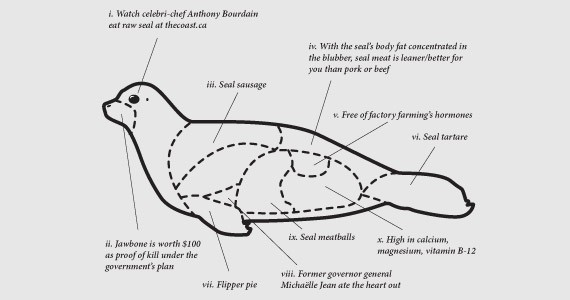You are using an out of date browser. It may not display this or other websites correctly.
You should upgrade or use an alternative browser.
You should upgrade or use an alternative browser.
Making seals popular
- Thread starter Eden Island
- Start date
John Ingram
Well-Known Member
how about nation wide............A Mickey D burger called "The Big Phoque"Needs a BC spin
Last edited:
Whole in the Water
Well-Known Member
I've had smoked sea lion a couple of times - it is very rich. Can't eat too much of it - sorta like Eulachon oil that way. I did send away for the seal capsules from the East Coast suppliers that have healthy amounts & proportions of various essential lipids/fatty-acids as shown on the label:
Attachments
IronNoggin
Well-Known Member
I think the fact the results of these contaminant samples are not being publicized suggests perhaps there is a toxicity problem. If not I suspect we would have heard by now.
Hardly. As is usual in the world of science, those who happen top be in the know are not permitted to release study conclusions until they are peer reviewed and published. You are likely aware of this as I have directly mentioned it to you on this forum multiple times.
I would suggest that jumping to unsupported conclusions is simply that - jumping to unsupported conclusions.
Cheers
SpringFever552
Well-Known Member
Grind them up and send it to the mink farms already
Sealing the Future: A Call to Action
The federal government has neglected the commercial seal harvest, contributing to the steep decline of the country’s once-vibrant sealing industry.
sencanada.ca
Biggs Killer Whales eat lots of seals and supposedly have very high toxin levels:
 www.eopugetsound.org
www.eopugetsound.org
Status and trends for West Coast transient (Bigg’s) killer whales in the Salish Sea | Encyclopedia of Puget Sound
Officially known as West Coast transients but increasingly referred to as Bigg’s killer whales, these marine mammal-eating orcas (Orcinus orca) are spending increasing time in the Salish Sea to consume their marine mammal prey including harbor seals, Steller sea lions, and harbor and Dall’s...
Despite the population’s growth over the last three decades, Bigg’s killer whales are at risk from numerous anthropogenic threats. They carry extremely high levels of persistent organic pollutants (e.g. PCBs and DDTs) due to their high trophic level (Ross et al. 2000). Concentrations of PCBs differ between males (251.2 +/- 54.7 mg kg-1) and females (58.8 +/- 20.6 mg kg-1), as females transfer some of their toxin load to their offspring through lactation, but were found to be substantially higher than in resident killer whales or St. Lawrence beluga whales who are known to be highly contaminated (Ross et al., 2000)
IronNoggin
Well-Known Member
Senate committee urges seal hunting education in schools
The Senate fisheries committee is calling for school boards nationwide to integrate education on seal hunting into their curricula.Blacklock's Reporter says the initiative aims to revive an industry that has struggled to remain economically viable.
“Educating young people about the environmental and economic significance of the Canadian seal harvest is of vital importance,” stated the committee’s report, Sealing The Future: A Call To Action.
The report emphasized that including lessons on the seal harvest in school curricula would help youth understand and appreciate this Canadian industry.
The report recommended using storytelling as an educational tool to convey the social, economic, and sustainability aspects of Canada’s seal harvests. This approach, the committee believes, would help Canadians learn about the impacts of the industry.
During a testimony last September, Lorelei Roberts, Assistant Deputy Fisheries Minister for Newfoundland and Labrador, highlighted the lack of knowledge among schoolchildren about sealing.
Roberts recounted a conversation with a friend’s nine-year-old daughter who mistakenly believed that baby seals were being killed. Roberts clarified, “We don’t kill baby seals. We kill adult seals and there are a lot of seals, and it is the same as if we have meat from cows, meat from pigs. There is a purpose for an animal.”
The seal trade, once valued at $34.3 million annually, has plummeted to around $275,000 due to export bans by the European Union in 2009 and China in 2011. Despite the collapse, Japan, Hong Kong, and Vietnam remain significant markets for Canadian seal products. Hong Kong and Norway also import Canadian seal oil in bulk, according to the Canadian Food Inspection Agency.
The committee’s report noted that the industry has not recovered from these bans and is no longer economically viable for most fishers. The Department of Fisheries has not set hunting quotas since 2016, with very low harvest rates for both grey and harp seals between 2018 and 2022.
Reviving public interest in sealing will take time, the report acknowledged, but urged the Government of Canada to begin efforts immediately.
Fisheries Minister Diane Lebouthillier expressed optimism in her February testimony, comparing the potential resurgence of seal products to the past transformation of lobster’s market value.
“If we can eat beef, we can very well eat seal and advertise it,” said Lebouthillier, noting ongoing promotional efforts with the hotel industry to introduce seal dishes.
Lebouthillier shared her personal support for the industry, saying, “I wear it and eat it. I’m very positive. We already have companies that are ready to move forward whether it be food for animals, Omega-3, fur, tourism, food for humans.”

Senate committee urges seal hunting education in schools
The Senate fisheries committee is calling for school boards nationwide to integrate education on seal hunting into their curricula.
Similar threads
- Replies
- 6
- Views
- 578
- Replies
- 1
- Views
- 642
- Replies
- 12
- Views
- 946
- Replies
- 8
- Views
- 1K






